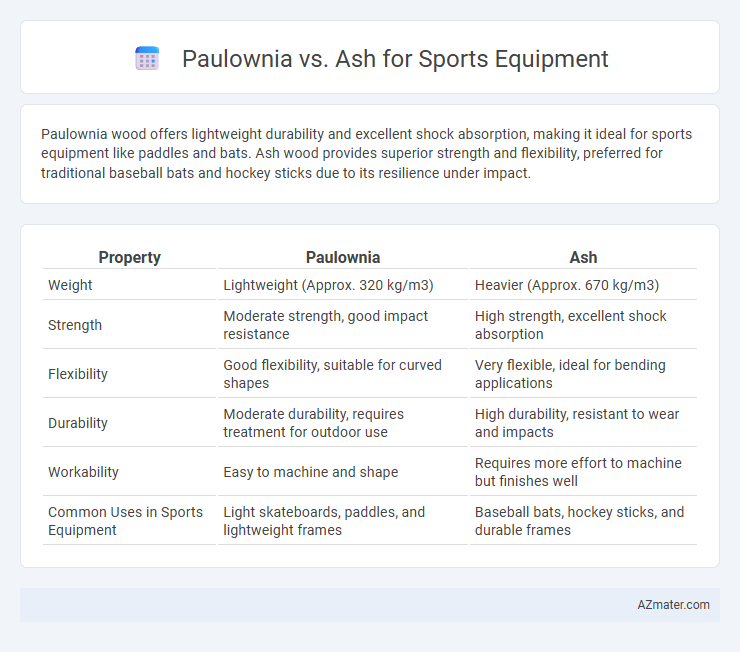Paulownia wood offers lightweight durability and excellent shock absorption, making it ideal for sports equipment like paddles and bats. Ash wood provides superior strength and flexibility, preferred for traditional baseball bats and hockey sticks due to its resilience under impact.
Table of Comparison
| Property | Paulownia | Ash |
|---|---|---|
| Weight | Lightweight (Approx. 320 kg/m3) | Heavier (Approx. 670 kg/m3) |
| Strength | Moderate strength, good impact resistance | High strength, excellent shock absorption |
| Flexibility | Good flexibility, suitable for curved shapes | Very flexible, ideal for bending applications |
| Durability | Moderate durability, requires treatment for outdoor use | High durability, resistant to wear and impacts |
| Workability | Easy to machine and shape | Requires more effort to machine but finishes well |
| Common Uses in Sports Equipment | Light skateboards, paddles, and lightweight frames | Baseball bats, hockey sticks, and durable frames |
Introduction to Paulownia and Ash Woods
Paulownia wood is lightweight, fast-growing, and known for its high strength-to-weight ratio, making it ideal for sports equipment that requires agility and durability. Ash wood is traditionally favored for its excellent shock resistance, flexibility, and strength, commonly used in baseball bats and hockey sticks. Understanding the distinct properties of Paulownia and Ash helps manufacturers select the best wood type based on performance requirements and sustainability goals.
Physical Properties: Strength and Weight
Paulownia wood offers an exceptional strength-to-weight ratio, making it significantly lighter than ash while maintaining adequate durability for sports equipment. Ash, known for its high density and superior impact resistance, provides greater toughness and stiffness, ideal for items requiring intense shock absorption. The choice between Paulownia and ash often hinges on the balance between lightweight performance and maximum strength needed in the specific sports application.
Durability and Longevity in Equipment
Paulownia wood offers a lightweight profile but lacks the dense fiber structure that enhances durability and longevity in sports equipment, making ash a preferred choice for items like baseball bats and hockey sticks that demand high impact resistance. Ash's superior tensile strength and shock absorption contribute to extended equipment lifespan under intense use. The denser grain and natural flexibility of ash reduce the risk of cracks and breakage, providing athletes with reliable performance over time.
Flexibility and Shock Absorption
Paulownia wood offers superior flexibility compared to ash, making it ideal for sports equipment that requires dynamic movement and resilience under stress. Ash is renowned for its excellent shock absorption properties, providing enhanced impact resistance that protects athletes from repetitive jolts. Combining Paulownia's lightweight flexibility with Ash's strong shock absorption can optimize performance and durability in sports gear design.
Workability and Customization Potential
Paulownia wood offers superior workability due to its lightweight nature and soft grain, allowing for intricate shaping and excellent shock absorption, ideal for customized sports equipment. Ash, known for its toughness and elasticity, provides reliable durability and impact resistance, making it suitable for high-performance gear but more challenging to carve or modify. The customization potential of Paulownia surpasses Ash because it is easier to machine, enabling precise adjustments for tailored equipment designs in sports like baseball bats and paddles.
Cost Comparison and Market Availability
Paulownia wood, known for its lightweight and strength, is generally more affordable than ash, making it an attractive option for budget-conscious sports equipment manufacturers. Ash offers superior durability and shock absorption but comes at a higher cost and fluctuates in availability due to limited supply and regional restrictions. Market availability favors paulownia, with widespread plantations ensuring consistent supply, whereas ash faces periodic shortages impacting price stability and accessibility.
Environmental Impact and Sustainability
Paulownia wood offers a highly sustainable option for sports equipment due to its rapid growth rate and ability to sequester carbon efficiently, reducing overall environmental impact. In contrast, ash trees grow more slowly and require more extensive resource input, leading to higher ecological footprints when used in manufacturing. The lightweight nature of Paulownia combined with its renewable cultivation makes it preferable for producing eco-friendly sports gear compared to traditionally harvested ash.
Performance in Baseball Bats
Paulownia wood offers exceptional lightweight properties and shock absorption, making it ideal for baseball bats focused on swing speed and control. Ash wood provides superior strength and durability, enhancing ball exit velocity and impact resistance during play. Comparing performance metrics, Paulownia bats excel in maneuverability while Ash bats deliver power and longevity for intensive usage.
Suitability for Surfboards and Skateboards
Paulownia wood offers exceptional lightweight properties and high strength-to-weight ratio, making it ideal for surfboards that require buoyancy and agility in water. Ash wood, known for its superior flexibility and shock resistance, is preferred for skateboards to absorb impact and enhance durability during tricks and rides. Both woods balance performance and durability, but Paulownia excels in aquatic environments, while Ash dominates in land-based sports equipment.
Summary: Choosing the Best Wood for Sports Equipment
Paulownia wood offers lightweight strength and excellent shock absorption, making it ideal for sports equipment requiring speed and agility, such as baseball bats and paddles. Ash wood is renowned for its durability, stiffness, and impact resistance, perfect for gear like hockey sticks and baseball bats that endure heavy use. Selecting the best wood depends on the balance between weight, flexibility, and toughness suited for the specific sport and player preference.

Infographic: Paulownia vs Ash for Sports Equipment
 azmater.com
azmater.com